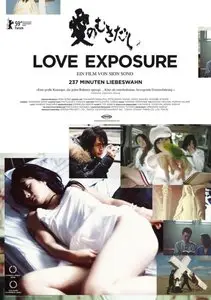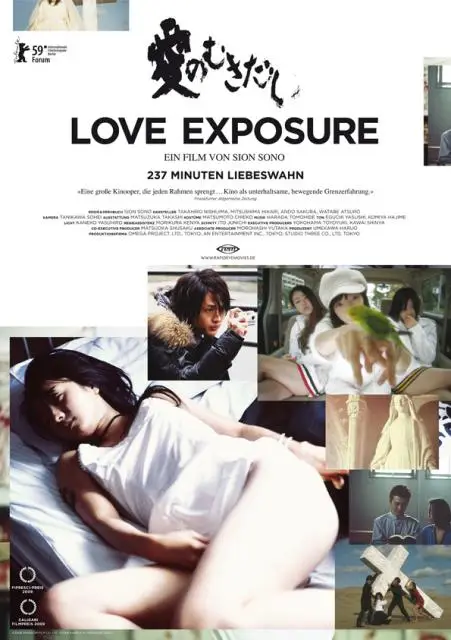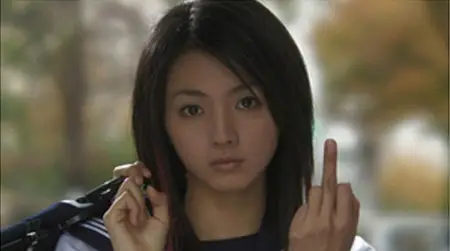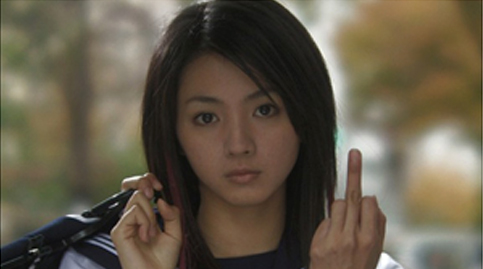Love exposure – Sion Sono (2008)
Japanese | Subtitle: English | 3:56:35 | 672 x 384 | NTSC | DivX | MP3 - 112kbps | 1400 MB
Genre: Drama
Japanese | Subtitle: English | 3:56:35 | 672 x 384 | NTSC | DivX | MP3 - 112kbps | 1400 MB
Genre: Drama
Cast: Takahiro Nishijima, Hikari Mitsushima, Sakura Andô, Hiroyuki Onoue, Yutaka Shimizu, Tasuku Nagaoka
Sold out show. Standby line. Director Sion Sono in person. A crowd from 18-80: men, women, White, Asian, Black, Latino, everybody, anybody with a taste for the real, weird, wacky. I don’t want to over hype the fest screening nor the film itself (which won the Fipresci prize at this year’s Berlinale and played to sold out shows in Japan for three months) but when one feels the energy popping like I did on Friday night, one can’t help but know exactly why cinema does the wonderful things it does. And Love Exposure contains many wonderful things – Catholicism, cults, up-skirt photography, kung fu, cross-dressing – and over its epic (lean) 4 hour running time it explores all this and more like no other film. Yet when it gets down to it, Love Exposure translates to three
words: susceptibility, devotion and yes, love (in all its quaint and twisted forms). So yeah, get ready, I’m going to ask the question, some of you have been wanting to know… is it Sono’s masterpiece? You bet. I’ll take it one further now… best film of the year? So far… And one more… Will people be expressing their joy for this with physical feats such as reenacting its bonkers street fighting scenes, while others do their geek dances, exclaiming it to be an instant classic? Why yes, how could they not?
So how in the hell do you write about a film like this? Well ultimately you don’t, as truly great cinema is beyond words and you have to urge people to just see it (and believe it). But a big movie denotes a big review, so for the benefit of you interested parties that have made it to this second paragraph (and hopefully beyond) I will – in the nature of the film- split this review into chapters pertaining to specific aspects of the film then try to piece it all back together.
Chapter 1: The story of the story
Why explain and ruin the plot of such a film? I’ll try not to, but to get a set-up across…
As Sono stated in the Q&A afterwards, the Japanese don’t carry that much faith with them. A majority of people who are Buddhists don’t practice Buddhism seriously, it usually only comes into play at funerals. The Japanese who are Christians seem more serious, taking their faith into account in their everyday lives. Here he tells the story of a Christian family, the Hondas, namely the son, Yu Honda (Takahiro Nishikima). As a little boy, Yu’s mother becomes ill, and before she dies, she gives Yu her statue of the Sacred Maria, tells her son she is going on a trip, and gets him to promise that one day he will find his own Maria and when he does to make sure to introduce her to his mother. Yu’s mother dies and his father, Tetsu (Atsuro Watabe) decides to become a priest. Fast forward to Tetsu’s quaint parish, where father and teenage son live happily, free of sin, healing people with their good deeds and words. But trouble is a brewing… Eccentric and needy minx, Saori shows up during one sermon, balling her eyes out. Tetsu takes pity on her and soon things get complicated, they begin a secret and forbidden romance, and Yu finds himself living right in the middle. Soon enough though Saori gets bored with Tetsu and bolts, leaving a bitter and broken man behind, a man who begins to take out his own shit on his son. Tetsu demands that Yu comes to confession everyday to extol for his sins, problem is, Yu doesn’t have any sins so he begins to make them up. Tetsu figures his son is lying, so to gain the forgiveness (and love) of his father, Yu starts sinning on a daily base, and is eventually trained by the venerable Master Lloyd in the art of up-skirt photography, something that requires sharp kung fu reflexes and “an erect heart”. In the process he gathers a gang of punk misfit buddies, infuriates and intrigues an odd seething girl named Aya (who just might be an influential cult member), and soon enough Yu is well on his way to his destiny, to his own “Sacred Maria”. As the title card states: 365 days till the miracle!
Chapter 2: Actors, Action!
Somewhere past the three-hour mark, my neck became locked in a position to the right (towards the screen), my legs went numb and my eyes burned, yet I could not turn away, get up, blink, blink, blink. How could I when a troupe of actors running the gauntlet of emotions where electrifying the screen, never feeling false, forced in their epic inner and outer journeys. At times operatic, over the top or just plain silly, it is all the joy of performances bursting with pathos. Sono gives his characters such spice, such desire and despair, that as much as they may act cartoonish at times, no one is a cartoon.
The effeminate Nishijima plays our hero, Yu, an optimistic boy out to please his father and fall in love, inexplicably becoming the king of the perverts along the way. He’s so enduring, impassioned and earnest how can one not like him? He may be a pervert but he is pure.
And then there is our street tough, Cobain and Christ loving heroine – and Yu’s Maria – Yoko, played by Hikari Mitsushima. When Yu falls in love at first sight, the audience has to too, and Mitsushima makes it happen. She might just give the best performance in the film, playing cutesy one minute and staring down a gang of thugs the next; the pint sized, epitome of Japanese school girl, Mitsushima does it all, sculpting a raw and ravaging sorrow and lust for true love onto what could have been a trite figure head of a role had it been played by someone else.
The three corners of this adolescent triangle are complete with Sakura Ando’s scheming Aya. The less said about her character the better, but what Ando does here is astonishing, painting a villainess for the ages with a quiet, brewing jealousy that is then etched into those seething eyes. Never has a girl in an all white 60s go-go uniform been so frightening, despicable and heart breaking. She’s a mastermind, a being devoid of love, denied love, desperately seeking love. In many ways I was reminded of Heath Ledger’s Joker portrayal, in that she also played the other characters like pawns in her game of chaos. The big difference is that she has a rich and dazzlingly told back-story, which makes one laugh as much as it shocks.
Chapter 3: Presentation and technique are go!
For a film that is as much about the base and sometimes-perverted nature of sex, it isn’t sexually graphic, and other than the constant bulge in Yu’s pants when he sees Yoko or the snapshots of girl’s panties, the film is quite chaste having no sex scenes or nudity to speak of. Now is it graphically violent? Hell yes! Thanks to Tokyo Gore Police director and low budget make up effects guru, Yoshihiro Nishimura, Love Exposure has some prime splatter, some awful, and awfully amazing body part severing, namely in Aya’s backstory. So we’ve got the slashes and gashes, what about the jabs and stabs? Actor, director and former street fighter, Tak Sakaguechi choreographs those dazzlingly delightful fights, not to mention the up-skirt kung fu antics of Yu and his gang.
But how does this all look and sound?
This is cinematographer Souhei Tanigawa’s second Sono collaboration, his first being Noriko’s Dinner Table. Shot in a variety of formats (though I honestly can’t tell if the bulk of the film was shot on HD or 35mm) Tanigawa’s work is dangerously intermediate at times with certain scenes coming off as flat, distractingly theatrical or just plain “video” in look, though this seems to be more or less because of the chosen formats they shot on. When they happens these may be the lowest points in the film from an aesthetic point, but for 90% of the time Tanigawa lenses with such tenacious yet fragile beauty, shots that either scream or whisper the utter desperation and ecstasy of youth, of faith, of love discarded, extolled, exposed.
Edited at a clip for most of its running time, leaving little room to catch ones breath at its highs and lows, the film marches to the beat of original J-pop tunes, an eerie underscore by Sono and Mitsuyo Isjigaki, and Western Classical. Never has Ravel’s tempo building “Bolero” sounded so good when set to the holy perverted quest of Yu . It, along with the melancholic journeyman Allegretto from Beethoven’s Symphony no. 7 is the pulse of the film, and just goes to show you how important music can be a driving force behind the nature of a story.
Chapter 4: Sion Sono; B-movie dreck or daring auteur?
Sono-san introduced Love Exposure, wearing a vertical striped jacket, a horizontal striped polo, prune colored pants, checkered socks and blue and brown shoes. This image sums up the man’s filmmaking styling, fairly if not definitively. He has been shrugged off by some critics as a showman and provocateur, shocking with a wild imagination being cheap, amateurish and lurid in execution. Though, yes he works with smaller budgets, all that critical brouhaha could be further from the truth. I believe Sono to be just as articulate and earnest in his storytelling and deconstruction of the modern Japanese (let alone human) psyche as say Kyoshi Kurosawa. He may be the eccentric who revels on the fringes of madness, but it is on those fringes where our pioneers play. His directing and writing here is as sharp as many of the old guard masters, recalling Fellini, Buneul, even John Cassavetes (!), Hong Kong martial arts spectacles and torrid romantic dramas.
With so much going on - subplots, back stories, wild twists and turns, slapstick comedy, severe psychological drama, street tough action, impassioned Biblical monologues – the film clearly can’t but help but jump all over the place (daring to dive into the far reaches of storytelling, if I haven’t already made that clear) yet Sono never loses focus, steering his film with an assured hand, weaving a poignant tapestry both of ancient mythological arcs and themes and urban existential ills, while tossing in a bunch of cinematic throwbacks and madly scribbling a couple thousand love letters to outsiders. The fact is Love Exposure is a very straightforward, usually linear, cohesive, coherent tale. The first hour alone presents some of the best on screen comedy I have ever had the pleasure to laugh at; it is absurd, sincere and never manages to totally evaporate from the film even as it spirals into darker territory.
Chapter 5: The long and the short of it is…
Love Exposure is fast, funny, frightening, sordid, soulful… and…I’m out of steam. If you’ve made it this far, congratulations, I think you’ll be able to handle a 4-hour film. So where to see it? If you’re in NYC or near by then head on over to the Japan Society this Tuesday. If not, well… the Japanese DVD is being released later this month, though rumored to be without English subtitles. Wherever you live the best thing to do is to check with local or regional festivals and demand they go after this for their line up, writing an e-mail or two to distributors can’t hurt either. So far they ain’t been chompin’ at the bit to put this out stateside or in Europe due to the running time. Tragic and frustrating for sure but if enough of us film geeks rise up and take action, someone should listen… Let’s hope so anyway because now more than ever, it is clear that Sion Sono is one of the most dynamic and exciting directors working in Japan, let alone the world.
RapidShare:
Part 1
Part 2
Part 3
Part 4
Part 5
Part 6
Part 7
Part 8
Part 9
Part 10
Part 11
Part 12
Part 13
Part 14
Part 15
Part 1
Part 2
Part 3
Part 4
Part 5
Part 6
Part 7
Part 8
Part 9
Part 10
Part 11
Part 12
Part 13
Part 14
Part 15
PW: malamute
english st:
RapidShare:
Part 16
Part 16
pw: malamute





